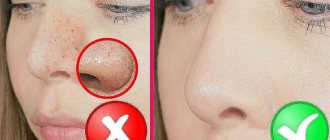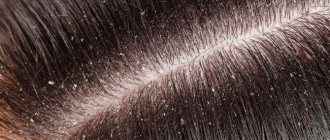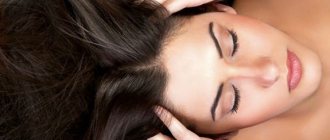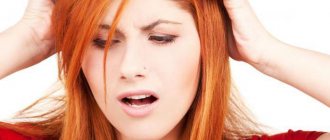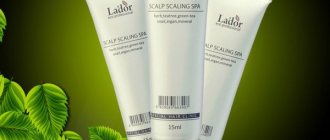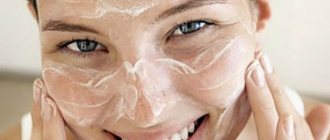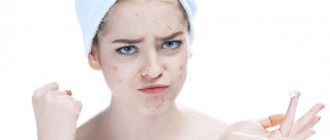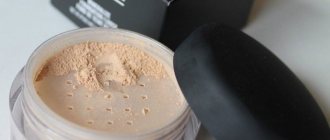Under the influence of various factors, the function of the sebaceous glands is disrupted; they begin to either produce sebum in excess or not enough. When it comes to disorders of the glands of the scalp, we speak of oily or dry seborrhea of the scalp.
What factors lead to disruption of the normal functioning of the sebaceous glands? This:
- Decreased immunity due to long-term chronic diseases, such as diabetes;
- Sudden changes in hormonal levels, for example in teenagers or pregnant women;
- Prolonged states of stress or depression;
- Metabolic disorders, such as obesity
- Other reasons.
Places where seborrhea appears: Many people believe that seborrhea occurs only on the scalp, but this is not so. Seborrheic dermatitis can affect any area of the skin where there are sebaceous glands.
- seborrhea of the scalp
Seborrhea of the scalp usually manifests itself as itching, flaking and dandruff. Dandruff in dry seborrhea is thin, translucent, and in oily seborrhea it appears as yellowish flakes. For seborrhea of this localization, treatment is usually carried out by a trichologist.
- seborrhea on the face
Seborrhea on the face occurs mainly during puberty and goes away on its own by the age of 25, but this does not mean that it does not need to be treated. The forehead, wings of the nose, nasolabial folds and chin, where most of the sebaceous glands are located, are most susceptible to damage. The process can also affect the growth areas of eyelashes, eyebrows, and mustaches.
- seborrhea on the body
On the torso, seborrhea most often affects the skin of the upper back and chest. The increased oiliness of these areas of the skin creates a favorable environment for the development of acne, causing physical and mental suffering to patients and reducing the quality of life.
Types of seborrhea and its manifestations (symptoms)
The following types of skin seborrhea are distinguished:
- dry, when there is a lack of sebum, and
- oily seborrhea of the skin when there is excess sebum
- combined, when different areas of the skin may have different manifestations
With excessive function of the sebaceous glands, symptoms of oily seborrhea appear:
- Hair acquires excessive shine and becomes greasy to the touch;
- The scalp and hair become greasy and dirty very quickly;
- The scalp may become covered with greasy yellowish crusts due to the fact that dead skin flakes are glued together with fat and the hair.
Excess sebum is an ideal nutrient substrate for fungi, which normally inhabit the skin of a healthy person in small quantities [1]. Under these conditions, they begin to actively reproduce, and act as an additional factor in the development and complications of seborrhea of the head. We are talking about fungi of the genus Malassezia; with very high activity of these fungi, inflammation of the skin can develop and then seborrhea turns into seborrheic dermatitis.
Often this disease must be differentiated from seborrheic eczema.
Obviously, in addition to inconvenience in the form of itching, seborrhea of the head brings patients a lot of cosmetic suffering - dandruff is noticeable on clothes and hair, creates an unkempt appearance, and the appearance of the hair is negated by all the efforts of hairdressers. And only treatment with modern effective means can help here.
Dry seborrhea
If the function of the sebaceous glands is reduced, they speak of dry seborrhea of the scalp.
Dry seborrhea is characterized by:
- Dryness, itching and flaking of the scalp;
- Excessive formation and flaking of scales (dandruff);
- Thinning, dry and brittle hair.
Oily facial seborrhea
Oily seborrhea of the face occurs in people with increased sebum production and is expressed in increased secretion and qualitative changes in sebum. Seborrhea often begins at the age of puberty at 14-16 years and is localized on the face, scalp, upper chest and back. Oily seborrhea is a provoking factor for the development of acne vulgaris and some other dermatitis. In cases where acne vulgaris appears against the background of oily seborrhea, the patient's skin falls into the category of sebaceous-sensitive, and then agents that reduce sebum production, such as retinoids, are indicated. If acne vulgaris is absent, then the patient’s skin falls into the category of sebaceous-resistant skin and its care should be limited to products aimed at reducing skin oiliness.
Diagnostics
Oily seborrhea is distinguished by characteristic symptoms. Despite this, the process of diagnosing seborrhea includes a set of measures.
First, the doctor gets acquainted with the patient's medical history. This allows you to determine what led to seborrhea. After this, he collects and analyzes his life history. This makes it possible to find out against what factors the pathology of the epidermis of the head developed. Then a thorough examination of the affected segments of the head is carried out and a complete clinical picture of the course of seborrhea is compiled.
Also, before treatment, comprehensive instrumental diagnostics are carried out. The doctor examines both skin and hair.
The main methods of examining the head and hair include:
- Skin scrapings and microscopic examination of hair.
- X-ray of the abdominal cavity.
- Ultrasound of the thyroid gland.
- CT and MRI.
Patients also undergo laboratory diagnostics. It includes a general and biochemical blood test, as well as hormonal tests. If necessary, a gynecologist and andrologist, a neurologist, an endocrinologist and other specialized doctors are involved in the examination, diagnosis and further treatment.
Clinical picture of oily seborrhea of the face
Clinically, there are 3 forms of seborrhea: 1) liquid, 2) thick, 3) mixed.
Liquid oily seborrhea on the face is characterized by increased secretion of sebum. The skin of the face is oily, shiny, the mouths of the sebaceous glands are enlarged and gaping. When the skin is squeezed, thin white sebaceous filaments are released. 2 hours after wiping with alcohol, the skin becomes greasy again.
The hair on the head shines as if it had been smeared with grease. The hair gradually thins, causing terrible discomfort for the patient. Very often, with liquid oily seborrhea of the face, vulgar acne appears. By the age of 26, the intensity of sebum secretion decreases, and the acne rash stops. Patients often show signs of neurovegetative dysfunction: increased sweating, impaired secretion of the gastrointestinal tract, changes in blood pressure with a tendency to hypotension, increased nervous excitability.
Thick, oily seborrhea of the face first appears again in adolescence against the background of increased sebum secretion, but predominantly there is a qualitative change in sebum. The skin becomes thickened and has a grayish-brown, dirty color. Thick seborrhea is complicated by various acne, atheromas (sebaceous gland cyst - a tumor-like formation resulting from blockage of the sebaceous gland duct), and multiple comedones.
Atheromas are nodules embedded in the thickness of the skin, ranging in size from a large pea to a hazelnut, with a dough-like consistency, after opening which a thick, fatty white mass is released from the cyst cavity, consisting of sebum and keratinized cells, with the smell of rancid fat. The skin over the atheromas has a normal color, but when the atheromas become inflamed, they fester, and then the skin over them becomes red. After opening, scars often form.
Thick seborrhea subsides by the age of 30. Typically, a patient with this form is not at risk of hair loss or baldness. Disturbances of the neurovegetative system are rare.
Signs of liquid oily seborrhea most often appear on the face and scalp, and thick ones - on the skin of the chest and back.
With a mixed form of seborrhea, symptoms appear on the same areas of the skin.
Seborrheic dermatitis on the scalp and sebaceous glands
The secretion of the sebaceous glands is a mixture of lipids and is called sebum. It is necessary for the healthy functioning of the skin: moisturizing it, maintaining elasticity, creating an antimicrobial protective barrier.
The skin is covered unevenly with sebaceous glands; there can be from 4 to 380 ducts per 1 cm2. They lie in the middle layer of the skin - the dermis, between its papillary and reticular layers. The largest number of sebaceous glands are located in the so-called “seborrheic zones”: on the skin of the face and body (back, neck, scalp, pubis, chest, abdomen, shoulders, forearms, legs). There are no sebaceous glands on the skin of the soles and palms.
For the most part, the ducts of the sebaceous glands open at the mouths of the hair follicles. In smaller numbers, the excretory ducts open directly onto the surface of the epidermis - in the area of the eyelids, borders of the lips, external auditory canal, nipple halos, and anus.
The size of the glands and the amount of lipid secretion depends on various factors: the functioning of the endocrine, nervous, reproductive systems of the body, age. In young children, the sebaceous glands secrete very little secretion. By adolescence, their work increases sharply, but as they grow older, their activity decreases. In adult men, sebum is constantly secreted in approximately the same amount; in women, this process is often associated with the menstrual cycle. In old age, the amount of secretion released decreases.
Care and treatment for oily facial seborrhea
To keep your skin clean and remove excess sebum from its surface, you should wash your face in the morning and evening, first with warm water and a cleanser specially designed for oily facial skin, and then wash with cool or cold water (to constrict blood vessels).
! Even washing with plain water raises the pH level of our skin because water has a pH of 7
For oily facial seborrhea, the use of external zinc-containing preparations – zinc oxide and activated zinc pyrithione – is indicated.
Who is susceptible:
— Seborrhea in children
In childhood, seborrhea most often occurs in infants under 3 months and has a special name “gneiss”. It is located on the scalp in the form of fatty yellow scales. Over time, the crusts can dry out and look like dandruff. Usually, with age, gneiss goes away on its own, and the function of the sebaceous glands is restored.
— Seborrhea in adolescents
In adolescents, seborrhea is associated with hormonal changes in the body and most often affects the face, torso and scalp. Excess secretion of the sebaceous glands is an excellent environment for the growth of fungi of the genus Malassezia, which feed on fatty acids from sebum and cause inflammatory processes.
- Seborrhea in women
The risk of developing seborrhea increases at the age of 15-25 and after 40. Women are less likely to develop seborrhea than men, and their symptoms are less active. The picture of seborrhea is most pronounced in women with elevated androgen levels, for example, with PCOS. Therefore, by normalizing the level of hormones in the blood and careful regular skin care, the manifestations of seborrhea in women can be minimized.
— Seborrhea in adults
Since seborrhea usually begins in adolescence due to an increase in the concentration of testosterone in the blood, the disease becomes easier with age. Often the condition worsens in winter due to insufficient indoor air humidity, so the composition of sebum changes. This contributes to the excessive development of Malassezia fungi and their transition to a pathogenic micellar form.
Vulgar acne
One of the most common skin diseases, affecting up to 85% of people aged 12 to 25 years and 11% of people over 25 years of age. Acne can lead to disfigurement and permanent scarring. But even mild cases cause significant emotional distress and have serious psychosocial consequences. Acne is a disease of the hair follicles and sebaceous glands. Four interrelated factors are important in pathogenesis: 1. Pathological follicular hyperkeratosis
– this is a violation of the processes of keratinization, which leads to blockage of the follicular duct by horny scales and the formation of a comedon (black head).
Subsequently, closed comedones turn into inflammatory papulopustular elements and transform into open comedones. In closed comedones, the drainage of sebum and waste products of Propionibacterium acnes is completely blocked. The created oxygen-free conditions are an optimal environment for the rapid proliferation of microorganisms. 2. Excessive formation of sebaceous gland secretion
, which is a substrate for the proliferation of P.acnes, and also leads to pronounced cosmetic defects due to the formation of deep sebaceous cysts (atheromas).
3. Microbial colonization
, in particular the proliferation of P. acnes.
4. Inflammation and immune response
. Acne is not a primarily immune disorder. P.acnes causes inflammation in the dermis (deep layers of the skin), and the epithelium (surface layers of the skin) is damaged by proteolytic enzymes. First, migration of lymphocytes occurs at the site of inflammation. Neutrophilic leukocytes penetrate the lesion and it is they who contribute to even greater damage to the follicle epithelium as a result of lytic enzymes. Highly active radicals (oxygen free radicals, hydroxyl groups, hydrogen peroxide superoxides) accumulate in the dermis, which further damage cells and support inflammation. Inflammation develops at any stage of acne. Today there is no single classification of acne. Existing classifications of acne are based on the clinical picture of the disease or on an assessment of its severity. The most successful is the etiopathogenetic classification. In this review, it is presented with the aim of expanding the understanding of this problem, which will allow us to determine the significance of the disease and optimize the creation of drugs for local and systemic use for the above-mentioned disease.
What is the difference between dandruff and seborrhea?
Ordinary dandruff is a mild form of seborrhea, which, as a rule, does not require treatment, just proper care - using a mild detergent that does not irritate the skin.
In the case of dry seborrhea, skin flakes (dandruff) easily flake off and settle in large quantities on the hair and shoulders. Hair may become thinner and break easily.
If seborrhea is oily, the skin flakes (dandruff) stick together, often sticking to the hair and forming yellowish, greasy crusts. With oily seborrhea, the hair quickly gets dirty, becomes greasy, and often thins.
Manifestations of seborrhea are noted in those places where the sebaceous glands are located: the face, mustache, eyebrows, upper chest, interscapular area and, in fact, the scalp.
Hair also changes with seborrhea, becoming greasy and shiny, it quickly becomes dirty, sticking together in strands.
Forms, features of the disease
Dandruff and unattractive hair appearance are just a partial manifestation of the oily type of seborrhea. The form of the disease largely influences how the hair and skin look. Experts highlight:
- Thick seborrhea. In this case, the dermis becomes dense and less elastic. The complexion and skin acquire a gray-brown tint. Abundantly secreted sebum changes its composition. It becomes thicker and clogs the sebaceous ducts, which leads to inflammation and blackheads. If you press on enlarged pores, you may notice a thick, viscous discharge. In advanced cases, atheromas (cysts on the skin) form, which require surgical intervention. The doctor opens them and pumps out the contents. In its thick form, oily hair becomes rough and hard to the touch.
- Liquid seborrhea. The skin on the head resembles the peel of an orange: it literally shines, and sebaceous formations stand out from the enlarged pores. Hair has an unhealthy shine, as if it has been oiled. They stick together, and in severe forms of seborrheic dermatitis they begin to actively fall out. My head itches all the time. Dandruff has a yellowish tint to the fat.
Seborrhea is contagious
Seborrhea is not contagious, so you should not avoid communicating with people who have dandruff or seborrhea on their faces. If everything is in order with your immunity and the functioning of the sebaceous glands, then even if fungi of the genus Malassezia come into contact with your skin, nothing will happen. This fungus is already constantly present on your skin without causing problems.
Therefore, neither the use of a common comb, nor a hat, nor a towel threatens your health if you do not have a predisposition to seborrheic dermatitis and a strong immune system. Seborrhea is also not transmitted by airborne droplets, touching the head or shaking hands.
Treatment of seborrhea
Treatment of seborrhea is selected individually. As a rule, proper care or sebum-regulating agents, as well as external preparations, are sufficient to reduce the activity of Malassezia fungi.
In the case of seborrhea, the following may be additionally prescribed:
- vitamin preparations;
- enterosorbents (for detoxification);
- restoratives.
Types of shampoos for seborrhea
The complex treatment of seborrhea of the head must include a special medicated shampoo, which should not only wash away impurities and excess sebum from the hair and scalp, but also have an antimicrobial and antifungal effect, relieve inflammation, reduce itching and irritation of the skin.
Shampoos against seborrhea are conventionally classified into groups depending on the active substance included in their composition.
The most common are shampoos whose active substance is:
- tar;
- ketoconazole;
- salicylic acid;
- activated pyrithione zinc.
Groups of agents for topical use in the treatment of seborrhea:
- antifungal;
- soothing itching;
- softening, moisturizing;
- sebum-regulating.
Acne classification
A
.
Constitutional acne 1. Seborrheic acne in childhood adolescence and adolescence: - acne of newborns - acne of infants - juvenile acne 2. Late acne: - premenstrual acne - postmenstrual acne - late hyperandrogenic acne in women - conglobate cystic acne in
men
B. Provoked acne 1. Artificial acne (mechanical, traumatic) 2. Oil acne (including professional acne) 3. Cosmetic (can be considered as a contact variant, usually found in women 20-30 years of age who abuse cosmetics). 4. Excoriated (In most cases, it manifests itself in a mild form. Each new rash is squeezed out, scratched or processed with some instrument. A smooth transition of this acne into a disease with abnormal neurotic behavior is possible. Some authors distinguish three degrees of severity of acne: mild form acne is diagnosed mainly in the presence of non-inflammatory elements - closed and open comedones. The moderate form is characterized by the presence of papulopustular elements on the face and torso. The severe form is characterized by a large number of papulopustular elements, as well as conglobate and cystic forms of acne. In recent years, acne treatment has been carried out taking into account pathogenetic aspects and therefore has become more targeted. Diet
... Food does not affect the amount and composition of sebum and the processes of keratinization of follicles. However, individual observations of patients should be taken into account.
Psychotherapy
... Patients with acne often suffer from disfiguring facial changes.
Acne is not caused by mental factors. Acne therapy itself is based on effective therapy, and not on psychotherapy. Psychotherapy that accompanies treatment can help in certain situations. Drug treatment
. Local and systemic therapy is used to treat acne. Topical treatment is indicated only for mild to moderate non-inflammatory acne, mild inflammatory acne without scarring, and as adjunctive therapy for moderate to severe acne. The most actively used drugs, both systemic and local, are retinoids. They act on follicular hyperkeratosis. Retinoids are universal inhibitors of lipogenesis and sebum secretion, normalize keratinization processes, and reduce the inflammatory response. The most well-known drugs are: tretinoin, airol, differin, isotretinoin, lokatsid, retin-A, clinesfar. An isotretinoin derivative, roaccutane, is used as a systemic drug. In addition to retinoids, you can influence excess sebum production with the help of antiandrogenic substances. Most are oral medications. The most famous are: Androcur, Diane-35, spironolactone. The latter can be used in 3-5% concentration, but it, as a rule, has a weak therapeutic effect. Microbial colonization of the follicle is affected by antibiotics and antiseptics, which are used both as local agents and internally. The most commonly used are tetracycline, erythromycin, and clindamycin. One of the options for local anti-inflammatory treatment of acne is curiosin gel. It contains natural components - hyaluronic acid, zinc, substances that are part of many tissues of the human body, primarily the skin. The drug is recommended by manufacturers for the treatment of any form of acne, however, as a result of long-term observations of the practical use of the gel, a lack of clinical effectiveness in its use has been established. In addition to specific local and systemic drugs that affect the pathogenesis of acne, patients often require additional measures (adjuvant therapy).
SKIN-CAP products
Modern clinical research [2] in the field of dermatology indicates the positive effect of products based on activated zinc pyrithione in the treatment of seborrhea - shampoo and aerosol SKIN-CAP.
The use of the products helped to eliminate the symptoms that bothered patients within 1-2 weeks of use [2].
The SKIN-CAP line includes medications in the form of cream, aerosol and shampoo; as well as skin care cosmetic product Skin-cap shower gel.
All forms of this drug are characterized by:
- High antimicrobial, antifungal and anti-inflammatory activity, due to which SKIN-CAP not only helps in relieving symptoms, but acts directly on the cause of these symptoms;
- High level of safety [4], thanks to which SKIN-CAP cream and aerosol are recommended for use by all categories of adults and children from 1 year of age [3];
- Wide choice of forms - the drug is available in 3 forms, which means that the doctor can easily select a flexible individual treatment regimen for a patient with any type of seborrhea in different parts of the body.
Shampoos with zinc against seborrhea
Today, shampoos with zinc are very popular. More than a hundred brands produce shampoos with zinc to eliminate dandruff and seborrhea.
- SKIN-CAP shampoo is an original treatment based on activated zinc pyrithione, a substance with pronounced antimicrobial, anti-inflammatory and antifungal activity. The skin cap contains activated zinc pyrithione in a proportion of 1 g per 100 ml of the drug. Suitable for combating dry and oily seborrhea, dandruff and seborrheic dermatitis.
- Friederm Zinc is a cosmetic product based on zinc pyrithione. Contains a suspension of zinc pyrithione at the rate of 20 mg of active substance per 1 ml of shampoo. Helps eliminate dandruff, but is not therapeutic.
- Keto plus Keto plus is a medicinal antifungal shampoo. 1 ml of the drug contains two active components: pyrithione zinc (10 mg) and ketoconazole (20 mg). Keto plus is used for the treatment and prevention of scalp skin diseases such as pityriasis versicolor, seborrheic dermatitis, and dandruff.
- Cynovit Shampoo Cynovit is a cosmetic product used to combat dandruff on the head. It is recommended to wash your hair up to 2-3 times a week. The duration of the course is 1 month.

